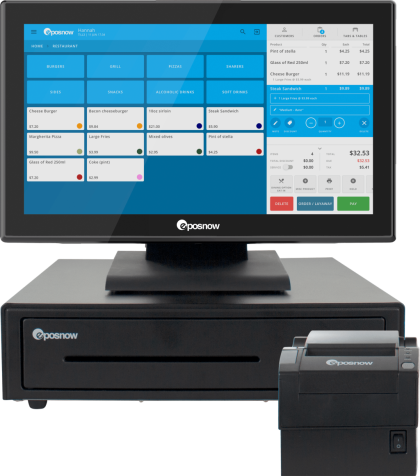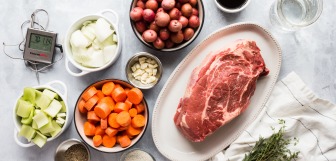How To Calculate Restaurant Food Cost: Formula Explained
How you price your restaurant’s dishes can make or break your business. Set a dish price too high, and customers will avoid it. Set it too low, and you won’t make enough money to cover your costs.
Lucky for you, we’ve got menu pricing down to a science. We’ll show you how to set prices that cover your expenses, keep your restaurant financially healthy, and don’t scare customers away.
One key thing to know for setting the right prices is your food cost percentage. This metric tells you how much of your sales go towards ingredients and food supplies. Keeping an eye on your restaurant food costs will help you set menu prices and profit maximization.
In this post, we’ll walk you through everything you need to know:
-
What is restaurant food cost?
-
How to calculate food cost percentage
-
Why food cost percentages matters
-
What a good food cost percentage looks like
-
How to lower cost of food used or your current food cost percentage
-
The finance behind it and how to set profitable menu prices
-
How to monitor the effect of menu pricing on sales
But before we get started on all that, there's one big question we need to answer.
What is food cost in a restaurant?
Food cost is basically how much you spend on ingredients (your food inventory) compared to how much money you make from selling those dishes (food sales). It's usually shown as a percentage called the food cost percentage. We'll get into that in a bit, so hang tight.
Now, some restaurants use food cost to figure out what it costs to whip up a dish. But others go with the Cost of Goods Sold (COGS), which is an ultra-detailed version. COGS includes everything, right down to the last toothpick, napkin, and those fancy garnishes on top. Yes, even that little parsley sprig counts!
How to calculate your ideal food cost percentage per meal
Alright, time to crunch some numbers! Don’t worry, it’s not as scary as it sounds. Figuring out your food cost percentage per meal is like peeling an onion—just take it one layer at a time. Here’s a step-by-step guide to get you there.
1. Figure out your cost of goods sold
First up, we need to figure out your COGS. This is just a fancy way of saying, “How much did you spend on all the ingredients for this dish?” It's time to calculate food costs. Add up everything: the main ingredients, spices, garnishes, and even the napkin you serve it with. Be thorough! If you’re making a burger, this means counting the cost of the bun, meat, cheese, lettuce, tomato, ketchup, and so on -yes, even that secret sauce.
Restaurant software (which can sometimes be referred to as food cost software) can make this a whole lot easier. With the right point of sale system, you can track ingredient costs and inventory in real time, eliminating the guesswork. You can input your ingredient prices and the system will automatically calculate your COGS for each dish. No more manual spreadsheets or scribbled notes—just accurate, up-to-date information at your fingertips. This way, you can stay on top of your costs, adjust prices as needed, and make sure you have really profitable menu items. Plus, it’ll give you more time to focus on perfecting that secret sauce!
2. Calculate your total sales
Next, let’s see how much you’re making from selling that dish. Look at your sales records and note down the total revenue from the meal. This is the fun part where you see the cash rolling in! If you sold 50 burgers at $10 each, your total sales are $500. Easy, right?
3. Use the food cost formula
Now it’s time to put it all together with a simple formula. Don’t worry, no advanced math here. Here's the actual food cost percentage formula you need:
Food Cost Percentage = (COGS / Total Sales) x 100
So, if your COGS for the burger is $2 and you sell it for $10, the formula looks like this:
Food Cost Percentage = (2 / 10) x 100 = 20%
Food cost per meal example
Let’s walk through a full example. Imagine you’ve got a killer pasta dish. The ingredients cost you $4, and you sell it for $16.
Food Cost Percentage = (4 / 16) x 100 = 25%
So, your total food cost percentage for this meal is 25%. Not too shabby! This means 25% of the selling price goes towards covering the cost of ingredients. The goal is to keep this percentage in a range that lets you cover expenses and still make a tidy profit. Adjust as needed to keep your restaurant in the green and your customers happy!
Understanding your food cost per serving
Let’s get down to the nuts and bolts - how much does each serving cost you? Knowing your food cost per serving helps you set the right prices and maximize profits. Let’s get into the steps!
Determine the ingredients costing of a dish
First, you need to figure out how much each ingredient costs for a single dish. This means breaking down the cost of every component, no matter how small. Got a chicken Alfredo? Calculate the cost of the chicken, pasta, sauce, cheese, and any herbs or spices. Don’t forget those sneaky extras like oil or butter used in cooking!
Calculate the menu item price per customer
Next, decide how much you’ll charge your customers for this dish. This is your selling price. It’s important to strike a balance between covering your costs, making a profit, and keeping your prices attractive to customers. If your chicken Alfredo costs you $5 to make, and you decide to sell it for $15, that’s your menu item price.
Apply the food cost per dish formula
Now, it’s formula time! You need to apply the food cost formula to find out the percentage of your sales price that goes into making the dish.
Food Cost Percentage = (Cost of Ingredients / Selling Price) x 100
So, for that chicken Alfredo:
Food Cost Percentage = (5 / 15) x 100 = 33.3%
Total cost of ingredients per dish example
Let’s walk through a full example. Say you’ve got a classic burger. Here’s the breakdown:
-
Bun: $0.50
-
Patty: $2.00
-
Cheese: $0.75
-
Lettuce, tomato, onions: $0.50
-
Sauce: $0.25
Total cost: $4.00
If you sell this burger for $12, the restaurant's food cost percentage formula looks like this:
Food Cost Percentage = (4 / 12) x 100 = 33.3%
So, using a restaurant food cost calculator, the food cost percentage for your burger is 33.3%. This means one-third of your selling price goes towards the ingredients. Keeping track of this helps you price your menu items just right to stay profitable and keep customers coming back for more!
Importance of food cost percentage for your restaurant
Understanding your food cost percentage is really important for your restaurant’s success. Here’s why it’s a big deal (and how it can make you look like a culinary genius).
Optimize your restaurant’s profit margins
Knowing your food cost percentage helps you boost those profit margins. It’s all about making sure you’re not spending more than you’re making. By keeping an eye on the numbers, you can adjust prices or portions to ensure you’re raking in the dough (not just kneading it).
Enhance your menu pricing strategies
Next, it’s a game-changer for your menu pricing strategies. Want to know if that fancy lobster dish is worth it? Check the food cost percentage. If it’s too high, you might need to tweak the price or swap out some ingredients. This way, you can keep the menu balanced between customer favorites and your bank account’s best friends.
Improve inventory control
Last but not least, it helps with inventory control. No more mystery ingredients lurking in the back of the fridge (we’ve all been there). By understanding food costs, you can order just what you need and use it efficiently. This means less waste and more savings. Plus, you’ll avoid the dreaded “Oops, we’re out of that” moment with customers.
So, there you have it. Knowing your food cost percentage isn’t just about crunching numbers—it’s about making smart decisions that keep your restaurant thriving. Now, go forth and conquer those costs like the culinary rockstar you are!

Run the restaurant you've always wanted
Host with confidence when you rely on Epos Now's dedicated restaurant POS. Process multichannel sales in-house, takeaway, and delivery, all in one place!
Strategies to control your food costs
Keeping food cost control is crucial, and we’ve got some killer tips to help you do just that.
Monitor inventory levels frequently
Picture this: you’re in the middle of a Friday night rush, and suddenly you’re out of buns for your burgers. Panic sets in, and you’re scrambling to fix the situation while your customers grumble. (Yikes!)
To avoid this chaos, keep a close eye on your inventory. Regularly check what you have on hand to ensure you’re not running low or overstocked. Using a point of sale system can make this a breeze. It helps you track inventory in real-time and get alerts when things are running low.
Build strong relationships with your suppliers
Think of your supplier as a secret ally in the food world. You’re not just buying ingredients. No, you’re forging a friendship that could score you better deals and fresher goods. (Who knew grocery shopping could be so social?) Building a solid relationship with your suppliers means they’ll keep you in the loop about price changes and maybe even offer you some VIP treatment. Send a thank-you note, or just butter them up—your charm could translate into discounts or priority service. Plus, a friendly relationship means you’re more likely to get that emergency delivery of fresh basil when you need it most.
Focus your menu planning on the most profitable dishes
Focus on those menu items that bring in the most profit. Analyze your total food sales data (hello, point of sale software) and see which dishes are the crowd favorites and moneymakers. Once you know what’s hot, you can start doing some menu planning and design your menu to highlight these stars. Maybe even tweak some recipes to boost their profitability even more.
TIP: Check out our guide on the highest profit margin food items. It’s packed with juicy details on which dishes will give your bottom line a big boost.
Implement a food waste management strategy
Finally, tackle food waste head-on. No one likes to see good food go to waste, especially since it’s money out of your pocket. Implement a food waste management strategy to keep track of what’s being tossed and why. This might mean adjusting portion sizes, using leftovers creatively, or donating excess food. A good point of sale system can help here, too, by showing you which menu items aren’t selling well and might be contributing to waste.
So there you have it—four solid strategies to keep your food costs under control. Keep your inventory tight, your supplier relationships strong, your menu smart, and your waste minimal. Your wallet (and your peace of mind) will thank you!
FAQs about food expenses management
- How do restaurants manage food costs?
-
Most restaurants and restaurant operators manage food costs by keeping a close eye on a few key things. They track how much they’re spending on ingredients, adjust menu prices based on those costs, and use inventory management to prevent waste and work out your ending inventory. Plus, they often negotiate with suppliers to get the best deals. Think of it like balancing a checkbook, but with burgers and fries. Using restaurant software can make all this easier by giving real-time updates and tracking your expenses automatically.
- How do you calculate food amounts?
-
Calculating food amounts is all about figuring out how much of each ingredient you need for a recipe and then scaling that based on how many portions you’re making. For example, if your burger recipe needs 1 pound of beef for 4 burgers, and you want to make 20 burgers, you’ll need 5 pounds of beef. Using a POS system can also help by keeping track of ingredient usage and telling you when to reorder.
- How much should a restaurant make a day?
-
There’s no one-size-fits-all answer here, as daily earnings vary based on location, size, and type of restaurant. Generally, you want to make enough to cover your daily expenses and still make a profit. A good rule of thumb is to aim for a revenue that at least covers your food and labor cost, with some extra for rent, utilities, and a little wiggle room for unexpected expenses. If you’re hitting your targets and covering costs, you’re on the right track!
- What costing method do restaurants use?
-
Restaurants (and some fast food restaurants) typically use a few different costing methods, but one of the most common is the food cost percentage method. This involves calculating how much of your sales revenue goes towards overall food costs. Another method is the Cost of Goods Sold (COGS), which looks at the total cost of ingredients used. Both methods help you figure out if you’re costing a dish correctly and managing your food expense list efficiently.
- What is the easiest food to sell?
-
The easiest food to sell is usually something that’s simple, popular, and has a high profit margin so it's not denting your weekly operational budget. Think comfort foods like burgers, pizza, or tacos -these food served are crowd-pleasers and don’t require a lot of fancy ingredients so food prices tend to be cheap. As well as low food costs, they’re familiar to most people, which means less convincing to do. Basically, go for items that people love and that you can make with ingredients you already have.




